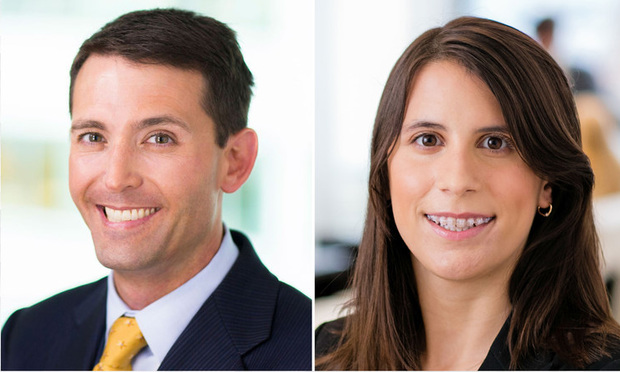Supreme Court Considers State Ban on Political Apparel in Polling Place
Does the First Amendment allow a state to prohibit voters from wearing “political” apparel, such as T-shirts and buttons, in the voting booth on Election Day? The U.S. Supreme Court will address this question in Minnesota Voters Alliance v. Mansky, setting up a clash between a state's interests in an intimidation-free polling place versus an individual's freedom of speech.
April 13, 2018 at 01:23 PM
5 minute read

Does the First Amendment allow a state to prohibit voters from wearing “political” apparel, such as T-shirts and buttons, in the voting booth on Election Day? The U.S. Supreme Court will address this question in Minnesota Voters Alliance v. Mansky, setting up a clash between a state's interests in an intimidation-free polling place versus an individual's freedom of speech.
Throughout each election cycle, Americans are bombarded with political speech on a daily basis. From TV commercials to yard signs to bumper stickers, it often seems like there is no escape from the entreaties. But, in fact, there is an escape—the voting booth itself.
To maintain an orderly environment on Election Day, all 50 states codified statutes regulating certain speech within the polling place. Minnesota's statute is among the broadest in the country. For example, Minnesota Statute Section 211B.11(1) prohibits individuals from wearing “a political badge, political button or other political insignia … at or about the polling place on Primary or Election Day.” If a person violates the statute, he could face civil penalties or even criminal prosecution.
In 2010, Andy Cilek went to vote at his local polling place in Hennepin County, Minnesota. His T-shirt displayed a Tea Party logo, bearing the message “Don't Tread on Me,” as well as a button with the text “Please I.D. Me.” When Cilek arrived at the polling place, an election worker told him to either cover up or take off the shirt and button. He refused and left. After three more attempts to enter the polling place, Cilek was eventually allowed to vote, but an election worker wrote down his name and address pursuant to Section 211B.11(1).
Just prior to the November 2010 election, several individuals and organizations, including Minnesota Voters Alliance (MVA), sued state officials to enjoin enforcement of Section 211B.11(1). They argued that the statute violated the First Amendment because it failed to advance legitimate interests or was overbroad. They also contended that the vagueness of the statute gave election officials unchecked discretion to arbitrarily decide which messages are “political.”
In response, Minnesota argued that the statute, which was enacted over a century ago, protects the right to vote in an orderly and controlled environment without confusion, interference or distraction. The state also pointed to Supreme Court precedent that political speech can be restricted outside of the polling place. Section 211B.11(1), Minnesota argued, was simply an extension of that principle inside the polling place.
The district court dismissed the complaint, finding that Section 211B.11(1) passed First Amendment muster. The U.S. Court of Appeals for the Eight Circuit affirmed the lower court's ruling on MVA's facial challenge but remanded the as-applied claims. On remand, the district court rejected MVA's as-applied challenge. MVA appealed again, and the Eight Circuit affirmed the lower court's ruling. The Supreme Court granted certiorari solely to address whether the statute was facially overbroad under the First Amendment.
The Supreme Court heard oral argument on Feb. 28, 2018. At the argument, some justices struggled with the necessity for a broad restriction at all. For example, Justice Neil Gorsuch asked whether there is any “documented need” for such an expansive ban on political apparel. He wondered what compelling interest Minnesota identified that required its statute to go so much further than the majority of states. Chief Justice John Roberts similarly reasoned that the relatively minor consequence for violation of Section 211B.11(1)— simply jotting down the name of the voter—suggests that the state's interests “might not be terribly strong.”
Other justices were more sympathetic to the underlying purpose of the law. Justice Stephen Breyer, for example, observed that the state was carving out a place for the voters to have a quiet place of thought and reflection on Election Day. Justice Elena Kagan similarly reasoned that there were clearly some places where political apparel is rightfully prohibited, such as a courtroom, but questioned why a polling place should also fall in that category. “Why isn't [the polling place] just the culmination of what is often a rowdy political process?” MVA pushed back on this point, arguing that “polling places are not pristine retreats from the real world,” and that a government cannot “sacrifice” the First Amendment to make them so.
Even setting aside Minnesota's interests, several justices questioned where to draw the line for identifying “political” speech. Justice Samuel Alito appeared most troubled by the state's amorphous definition, stating that it was “an invitation for arbitrary enforcement.” He questioned the state on a series of examples—would a shirt with a rainbow flag be permitted under the law? What about a shirt that says “Parkland Strong,” referring to the recent school shooting in Florida? What about an NRA shirt? A shirt with the text of the Second Amendment? A Colin Kaepernick jersey? The state conceded that some of these were “hard calls” and that there would always be hard calls, but that did not mean that the line that Minnesota drew is “unconstitutional or even unreasonable.”
The justices lobbed difficult questions to both sides without suggesting an ultimate result. It is fair to say, though, that the justices are generally protective of free speech, and the difficulty of drawing the line for “political” apparel might end up tipping the scale in favor of the challengers. A decision is expected later this year.
Stephen A. Miller practices in the commercial litigation group at Cozen O'Connor's Philadelphia office. Prior to joining the firm, he clerked for Justice Antonin Scalia on the U.S. Supreme Court and served as a federal prosecutor for nine years in the Southern District of New York and the Eastern District of Pennsylvania.
Pamela Dorian also practices in the firm's commercial litigation group. She received her J.D. from the University of Virginia School of Law and her B.A. from Pennsylvania State University.
This content has been archived. It is available through our partners, LexisNexis® and Bloomberg Law.
To view this content, please continue to their sites.
Not a Lexis Subscriber?
Subscribe Now
Not a Bloomberg Law Subscriber?
Subscribe Now
NOT FOR REPRINT
© 2025 ALM Global, LLC, All Rights Reserved. Request academic re-use from www.copyright.com. All other uses, submit a request to [email protected]. For more information visit Asset & Logo Licensing.
You Might Like
View All

AI and Social Media Fakes: Are You Protecting Your Brand?

Neighboring States Have Either Passed or Proposed Climate Superfund Laws—Is Pennsylvania Next?
7 minute read
Seven Rules of the Road for Managing Referrals To/From Other Attorneys, Part 2
6 minute readTrending Stories
Who Got The Work
J. Brugh Lower of Gibbons has entered an appearance for industrial equipment supplier Devco Corporation in a pending trademark infringement lawsuit. The suit, accusing the defendant of selling knock-off Graco products, was filed Dec. 18 in New Jersey District Court by Rivkin Radler on behalf of Graco Inc. and Graco Minnesota. The case, assigned to U.S. District Judge Zahid N. Quraishi, is 3:24-cv-11294, Graco Inc. et al v. Devco Corporation.
Who Got The Work
Rebecca Maller-Stein and Kent A. Yalowitz of Arnold & Porter Kaye Scholer have entered their appearances for Hanaco Venture Capital and its executives, Lior Prosor and David Frankel, in a pending securities lawsuit. The action, filed on Dec. 24 in New York Southern District Court by Zell, Aron & Co. on behalf of Goldeneye Advisors, accuses the defendants of negligently and fraudulently managing the plaintiff's $1 million investment. The case, assigned to U.S. District Judge Vernon S. Broderick, is 1:24-cv-09918, Goldeneye Advisors, LLC v. Hanaco Venture Capital, Ltd. et al.
Who Got The Work
Attorneys from A&O Shearman has stepped in as defense counsel for Toronto-Dominion Bank and other defendants in a pending securities class action. The suit, filed Dec. 11 in New York Southern District Court by Bleichmar Fonti & Auld, accuses the defendants of concealing the bank's 'pervasive' deficiencies in regards to its compliance with the Bank Secrecy Act and the quality of its anti-money laundering controls. The case, assigned to U.S. District Judge Arun Subramanian, is 1:24-cv-09445, Gonzalez v. The Toronto-Dominion Bank et al.
Who Got The Work
Crown Castle International, a Pennsylvania company providing shared communications infrastructure, has turned to Luke D. Wolf of Gordon Rees Scully Mansukhani to fend off a pending breach-of-contract lawsuit. The court action, filed Nov. 25 in Michigan Eastern District Court by Hooper Hathaway PC on behalf of The Town Residences LLC, accuses Crown Castle of failing to transfer approximately $30,000 in utility payments from T-Mobile in breach of a roof-top lease and assignment agreement. The case, assigned to U.S. District Judge Susan K. Declercq, is 2:24-cv-13131, The Town Residences LLC v. T-Mobile US, Inc. et al.
Who Got The Work
Wilfred P. Coronato and Daniel M. Schwartz of McCarter & English have stepped in as defense counsel to Electrolux Home Products Inc. in a pending product liability lawsuit. The court action, filed Nov. 26 in New York Eastern District Court by Poulos Lopiccolo PC and Nagel Rice LLP on behalf of David Stern, alleges that the defendant's refrigerators’ drawers and shelving repeatedly break and fall apart within months after purchase. The case, assigned to U.S. District Judge Joan M. Azrack, is 2:24-cv-08204, Stern v. Electrolux Home Products, Inc.
Featured Firms
Law Offices of Gary Martin Hays & Associates, P.C.
(470) 294-1674
Law Offices of Mark E. Salomone
(857) 444-6468
Smith & Hassler
(713) 739-1250





